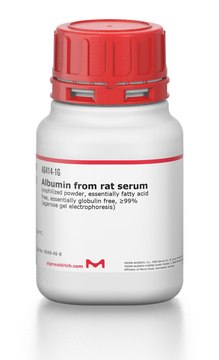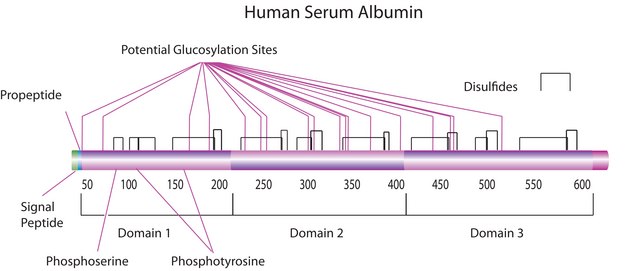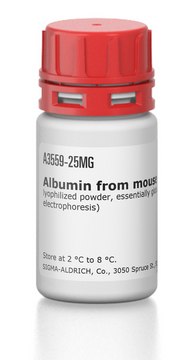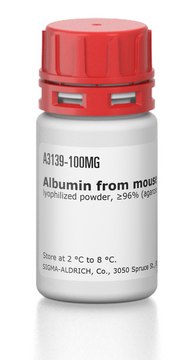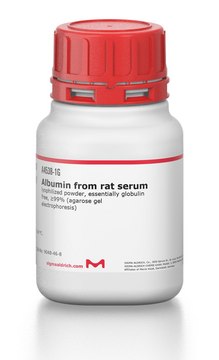A6272
Albumin from rat serum
lyophilized powder, ≥96% (agarose gel electrophoresis)
Synonym(s):
RSA, Rat albumin
Sign Into View Organizational & Contract Pricing
All Photos(4)
About This Item
Recommended Products
biological source
rat
Quality Level
Assay
≥96% (agarose gel electrophoresis)
form
lyophilized powder
technique(s)
ELISA: suitable
tissue culture: suitable
western blot: suitable
UniProt accession no.
storage temp.
2-8°C
Gene Information
rat ... ALB(24186)
Looking for similar products? Visit Product Comparison Guide
General description
Albumin from rat serum (RSA) comprises an N-terminal signal and propeptide sequence. RSA sequence has a single tryptophan residue.
Application
Albumin from rat serum has been used:
- in sulfo-4-(N-maleimidomethyl)cyclohexane-1-carboxylic,acid 3-sulfo-N-hydroxy-succinimide ester sodium salt (SMCC) derivatization studies
- as a component of dispersion media for the suspension of multi-walled carbon nanotubes (MWCNTs)
- as a macromolecular probe in microvascular solute flux measurements
Biochem/physiol Actions
Albumin from rat serum (RSA) mediates the transport of exogenous ligands. It is useful in fluorescence spectroscopy measurements with small-molecule ligands.
Storage Class Code
11 - Combustible Solids
WGK
WGK 3
Flash Point(F)
Not applicable
Flash Point(C)
Not applicable
Personal Protective Equipment
dust mask type N95 (US), Eyeshields, Gloves
Choose from one of the most recent versions:
Certificates of Analysis (COA)
Lot/Batch Number
Don't see the Right Version?
If you require a particular version, you can look up a specific certificate by the Lot or Batch number.
Already Own This Product?
Find documentation for the products that you have recently purchased in the Document Library.
Gabriel Zazeri et al.
International journal of molecular sciences, 20(12) (2019-06-20)
The bioactive piperine (1-piperoyl piperidine) compound found in some pepper species (Piper nigrum linn and Piper sarmentosum Roxb) has been shown to have therapeutic properties and to be useful for well-being. The tests used to validate these properties were performed
A K Vidanapathirana et al.
Journal of nanomedicine & nanotechnology, 5(3) (2014-06-01)
Multi-walled carbon nanotubes (MWCNTs) are increasingly used in industry and in nanomedicine raising safety concerns, especially during unique life-stages such as pregnancy. We hypothesized that MWCNT exposure during pregnancy will increase vascular tissue contractile responses by increasing Rho kinase signaling.
Sejal S Hall et al.
Biotechnology progress, 23(3), 749-754 (2007-05-02)
Peptide ligands capable of mediating nanoparticle adhesion to human red blood cells (RBCs) were identified from a large bacterial display peptide library. Peptides were displayed on the surface of fluorescent Escherichia coli, enabling quantitative measurement of RBC binding and high-throughput
Theo Hagg
Methods in molecular biology (Clifton, N.J.), 399, 167-180 (2008-03-04)
Neurotrophic factors are among the most potent neuroprotective and neuroregenerative agents known. However, they cross the adult mammalian blood-brain barrier very poorly and can have serious peripheral side effects. These problems can be solved by using chronic infusions with small
Joshua P Scallan et al.
The Journal of physiology, 591(20), 5071-5081 (2013-07-31)
Atrial and brain natriuretic peptides (ANP and BNP, respectively) are cardiac hormones released into the bloodstream in response to hypervolaemia or fluid shifts to the central circulation. The actions of both peptides include natriuresis and diuresis, a decrease in systemic
Our team of scientists has experience in all areas of research including Life Science, Material Science, Chemical Synthesis, Chromatography, Analytical and many others.
Contact Technical Service